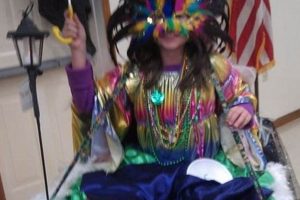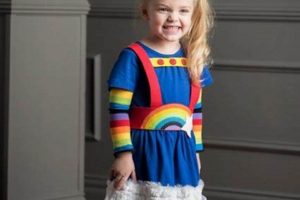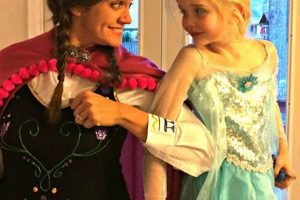A self-fashioned flight attendant uniform allows for creative expression when replicating the iconic look of airline personnel. This approach involves using readily available materials and craft skills to construct a representation of a cabin crew ensemble. An example includes modifying existing clothing items, such as a blazer and skirt, and incorporating details like scarves and homemade wings to achieve the desired aesthetic.
Creating these outfits offers a cost-effective and personalized alternative to purchasing pre-made costumes. Individuals can tailor the design to their specific preferences, body type, and budget. Historically, the attire of flight attendants has symbolized glamour and professionalism, and replicating it can evoke a sense of nostalgia and aspirational style.
The following sections will delve into specific methods, materials, and considerations for successfully assembling such a project, providing guidance on everything from sourcing components to achieving an authentic final appearance.
Essential Guidance for a Self-Made Cabin Crew Ensemble
Constructing a convincing flight attendant-inspired outfit requires attention to detail and adherence to certain stylistic conventions. These tips provide a framework for achieving a polished and recognizable final product.
Tip 1: Research Authentic Uniforms: Prioritize examining historical and contemporary examples of actual airline uniforms. Pay close attention to color palettes, cuts, and embellishments to inform design choices.
Tip 2: Source Quality Fabrics: Select materials that drape well and mimic the appearance of professional attire. Gabardine, suiting fabrics, and quality knits are often suitable choices.
Tip 3: Focus on Fit: Ensure the garment fits well. Alterations to existing clothing may be necessary to achieve a tailored and professional silhouette. A well-fitted garment contributes significantly to the overall impression.
Tip 4: Accessorize Appropriately: Accessories such as scarves, hats, and gloves should complement the primary garment and align with the chosen era and airline aesthetic. Avoid overly elaborate or distracting embellishments.
Tip 5: Consider Embellishments Carefully: Airline wings or pins should be sourced or crafted with precision. Their design and placement should accurately reflect authentic insignia.
Tip 6: Prioritize Comfort and Practicality: While visual accuracy is important, comfort and ease of movement should not be overlooked. The finished product should be wearable and allow for comfortable activity.
These guidelines underscore the importance of research, material selection, and attention to detail in replicating the specific attire. By adhering to these suggestions, one can elevate the outcome from a simple costume to a carefully crafted representation of an iconic uniform.
The subsequent sections will further explore the individual components of this effort, detailing construction techniques and providing resources for further refinement.
1. Pattern accuracy
The fidelity of a pattern directly influences the success of an “air hostess costume diy” project. Inaccurate patterns result in ill-fitting garments, diminishing the professional aesthetic associated with airline uniforms. Cause and effect are clearly linked; a flawed pattern inevitably leads to a flawed final product. The degree of pattern accuracy significantly affects the overall credibility of the self-made cabin crew attire.
Examples of pattern inaccuracies include improperly scaled dimensions, resulting in garments that are either too large or too small. Mismatched seams and incorrectly shaped collars contribute to a visibly amateurish outcome, undermining the intended effect. Furthermore, failing to accurately replicate the distinctive design elements of specific airline uniforms, such as the shape of a jacket lapel or the style of a skirt, renders the reproduction less authentic. Real-world instances of these errors are common among inexperienced garment constructors.
Ultimately, accurate patterns serve as foundational blueprints for these projects. Challenges in achieving perfection can be mitigated by sourcing patterns specifically designed for vintage or contemporary uniform replicas, or by seeking guidance from experienced seamstresses. The importance of pattern accuracy cannot be overstated; it is a crucial determinant of the final costume’s realism and overall success within the broader context of self-made airline-inspired attire.
2. Fabric selection
The choice of fabric is a critical determinant in the success of any “air hostess costume diy” endeavor. The material directly influences the garment’s drape, texture, and overall visual appeal, consequently affecting the realism and professional aesthetic of the finished product. Incorrect fabric selection can undermine even the most meticulously crafted pattern. For example, using a heavy, stiff fabric for a design that requires a flowing, lightweight material will result in a distorted and unconvincing representation of the intended uniform. Conversely, opting for a low-quality, easily wrinkled fabric will detract from the sense of sophistication typically associated with flight attendant attire.
Practical considerations such as durability and ease of care are also important. A uniform made from a fabric that is prone to staining or difficult to clean will be impractical for extended wear. Furthermore, the chosen fabric should be appropriate for the climate in which the costume will be worn; a heavy wool fabric would be unsuitable for a summer event, while a thin, breathable fabric would be preferable. Real-world examples demonstrate the importance of this factor. A costume intended to replicate a vintage 1960s uniform might benefit from a lightweight wool blend to achieve the correct silhouette and texture, while a modern uniform might utilize a polyester blend for its wrinkle resistance and durability.
In summary, the selection of fabric represents a crucial decision point in the “air hostess costume diy” process. It impacts not only the visual authenticity of the final product but also its practicality and wearability. Careful consideration of the fabric’s properties, in relation to the desired aesthetic and the intended use of the costume, is essential for achieving a satisfactory and credible result. Overlooking this element can significantly compromise the overall quality and impact of the self-made flight attendant attire.
3. Sewing skills
Proficiency in sewing techniques is fundamentally linked to the successful execution of an “air hostess costume diy” project
. The level of skill directly impacts the quality, accuracy, and durability of the final garment. Adequate sewing skills are necessary to translate patterns, manipulate fabric, and construct a wearable and aesthetically pleasing uniform.
- Pattern Interpretation and Adaptation
Effective sewing skills enable the accurate interpretation of commercial or self-drafted patterns. This includes understanding pattern markings, seam allowances, and cutting layouts. Furthermore, the ability to adapt patterns to individual body measurements or desired design modifications is essential for achieving a well-fitting and personalized costume. Real-world examples include adjusting a bodice pattern for a more flattering neckline or altering skirt length to match a specific era’s fashion. The implications of inadequate skills in this area are misinterpretations, incorrect fabric cutting, and a final garment that deviates significantly from the intended design.
- Construction Techniques
Mastery of basic and advanced sewing techniques, such as straight stitching, seam finishing, dart manipulation, and zipper insertion, is crucial for constructing a structurally sound and visually appealing uniform. Clean seam finishes prevent fraying and enhance the garment’s durability. Skillful dart placement shapes the fabric to the body, creating a tailored silhouette. Correct zipper insertion ensures a functional and professional closure. Without these skills, the resulting costume may exhibit visible flaws, such as puckered seams, uneven hems, and a generally unprofessional appearance. For instance, poor zipper insertion can render the garment unwearable.
- Fabric Handling and Manipulation
Different fabrics require different handling techniques. Understanding how to work with various materials, such as delicate silks, sturdy wools, or synthetic blends, is essential for achieving a polished result. This includes knowledge of appropriate needle sizes, thread types, and pressing methods. Improper fabric handling can lead to skipped stitches, puckered seams, or permanent damage to the material. An example of this is using too high heat on a delicate synthetic fabric, causing it to melt or distort. Therefore, mastering fabric handling ensures a smooth construction process and a more refined final product.
- Finishing and Detailing
Attention to detail is paramount in creating a convincing “air hostess costume diy” project. This includes meticulous finishing techniques, such as hand-sewing hems, attaching embellishments, and pressing seams to create a crisp, professional look. The ability to sew on buttons securely, create neat buttonholes, and attach accessories, like scarves or wings, with precision elevates the overall quality of the costume. Examples include ensuring that collars lie flat, cuffs are evenly aligned, and all loose threads are trimmed. Neglecting these details can detract from the overall impact of the costume, diminishing its credibility and aesthetic appeal.
In summation, sewing skills are indispensable for successfully undertaking an “air hostess costume diy” project. Competence in pattern interpretation, construction techniques, fabric handling, and finishing details directly translates to a higher-quality, more authentic, and ultimately more satisfying final product. Lacking in these essential skills can lead to various issues. These range from structural issues to aesthetics, ultimately impacting the overall realism and wearability of the homemade airline uniform.
4. Accessory details
The integration of appropriate accessories is paramount in achieving an authentic and recognizable representation within the domain of a self-made flight attendant uniform. Accessory selection and execution elevate a basic garment into a credible evocation of a specific airline aesthetic.
- Headwear Authenticity
Hats, caps, or other head coverings frequently constitute a defining element of cabin crew uniforms. The accurate replication of these items, including their shape, color, and embellishments, significantly contributes to the overall impression. Real-world examples include pillbox hats from the 1960s or more contemporary visor styles. The failure to accurately reproduce these specific details diminishes the impact of the uniform.
- Scarf or Necktie Precision
Scarves or neckties often bear specific patterns, colors, or logos associated with particular airlines. The selection of a similar scarf fabric (silk or synthetic blend) and the accuracy in replicating the pattern directly impacts the costumes authenticity. For instance, a scarf with an airlines specific logo or color palette, compared to a generic scarf, immediately enhances the credibility of the self-made attire. The selection of material of scarf plays a vital role in determining the success of costume.
- Insignia and Wing Placement
Airline wings or pins symbolize the wearer’s affiliation and role. The design, material, and precise placement of these emblems are crucial. Incorrectly positioned or poorly crafted wings detract from the uniform’s overall legitimacy. An example of an embellishment would be sourcing metal wings vs printed or plastic, affecting the look and feel.
- Gloves and Handbags: Era-Specific Elements
Depending on the era and the airline being represented, gloves and handbags may form integral parts of the ensemble. The style, color, and material of these accessories should align with the historical context of the uniform. A vintage-style handbag made with leather or a specific pattern from a brand makes a great accessory. The integration of these additional elements adds depth and detail to the overall presentation.
The cumulative effect of carefully chosen and accurately rendered accessories considerably elevates the perceived quality and authenticity of the self-fashioned cabin crew attire. These details transform a simple article of clothing into an accurate representation of cabin crew attire.
5. Uniform colors
Within the scope of “air hostess costume diy,” uniform colors represent a defining element of authenticity and recognizability. The specific hues and color combinations employed by airlines serve as immediate visual identifiers, linking the attire to a particular brand or historical period. Thus, the selection of appropriate colors directly impacts the success of replicating a credible cabin crew aesthetic. Incorrect color choices, even with accurate pattern and construction, can undermine the overall impression and diminish the desired effect. For example, using a modern teal shade instead of a vintage sky blue for a 1960s-era uniform would significantly detract from the authenticity of the piece.
Further emphasizing the practical significance, consider the legal implications related to trademark infringement. Certain airlines fiercely protect their brand identity, including their specific color palettes. While the intention of “air hostess costume diy” is typically for recreational purposes, awareness of potential trademark concerns is advisable. Beyond legal considerations, the practical application of color selection involves meticulous research. Scouring historical photographs, advertisements, and airline archives to determine the precise shades employed during a specific era is essential. Dyeing fabri
cs to match specific Pantone colors or carefully selecting commercially available materials that closely approximate the desired hues represents a crucial step in achieving accuracy. The implications of not choosing the right colors or similar fabric has a significant outcome.
In summary, uniform colors constitute a vital aspect of “air hostess costume diy,” influencing both the aesthetic appeal and the perceived authenticity of the final product. The accuracy in the selection of colors also helps convey the intended purpose of the costume. Challenges in color matching necessitate meticulous research and careful sourcing of materials. Overlooking this detail can significantly compromise the credibility and impact of the self-made cabin crew attire, and it is one of the first things to observe.
6. Fit/Alterations
The accuracy of fit within an “air hostess costume diy” project profoundly influences the ultimate success of the endeavor. A poorly fitted garment, regardless of the accuracy in color, fabric, or accessory details, detracts significantly from the professional aesthetic inherent in airline uniforms. The connection is direct: inadequate fit undermines the credibility and impact of the meticulously crafted attire. Conversely, appropriate fit enhances the silhouette, allowing the costume to convey the intended elegance and authority. The importance of alterations lies in bridging the gap between standard pattern sizes and individual body measurements, ensuring a tailored appearance that replicates the precision of professionally designed uniforms.
Consider the practical applications of fit and alteration within a real-world scenario. A commercially available pattern for a 1960s flight attendant jacket may not perfectly accommodate an individual’s shoulder width or bust measurement. Alterations, such as adjusting shoulder seams or adding darts, become necessary to achieve a flattering and accurate fit. Omitting these modifications results in a jacket that appears ill-fitting, regardless of the authenticity of its design elements. The application of these tailoring techniques will ensure proper fit of the costume. Furthermore, a skirt that is too long or too short will disrupt the proportions of the uniform, compromising the overall impression. Hemming or lengthening the skirt to achieve the correct length relative to the wearer’s height is crucial for maintaining visual harmony.
In summary, the relationship between fit, alterations, and a successful “air hostess costume diy” project is one of interdependence. Accurate fit elevates the appearance and authenticity of the uniform. Challenges in achieving optimal fit often necessitate skillful alterations, adapting patterns to individual body measurements and design requirements. Neglecting this essential component can diminish the impact of otherwise meticulous efforts, highlighting the practical significance of fit and alterations within the broader context of recreating a credible and visually appealing cabin crew attire.
7. Era/Airline
The selection of a specific era and airline forms the foundational framework for any “air hostess costume diy” project. This choice dictates a cascade of subsequent decisions, impacting the design, materials, and construction techniques employed in replicating the uniform. The era/airline choice establishes the visual parameters within which the project operates.
- Historical Accuracy in Design
The chosen era directly influences the silhouette, length, and overall design of the garment. For instance, a Pan Am uniform from the 1960s features a distinctive A-line skirt, whereas a contemporary Emirates uniform showcases a more fitted silhouette. Replicating the historical design mandates meticulous research and pattern adaptation. The implications of ignoring these era-specific design elements result in a visually anachronistic and less credible outcome.
- Material Selection Based on Period
Fabric types and textures vary across different eras. Vintage uniforms frequently utilized materials like wool blends and rayon, while modern uniforms often incorporate synthetic fabrics for durability and wrinkle resistance. Selecting appropriate materials that reflect the chosen period enhances the authenticity of the costume. An example: polyester blends would be suitable, being a durable material for a modern style uniform.
- Color Palette Consistency
Each airline and era exhibits a unique color palette. Accurately matching the specific hues employed by the target airline during the selected period is crucial for achieving visual fidelity. This may involve custom dyeing fabrics or meticulously sourcing materials that closely approximate the desired shades. Deviations from the established color palette undermine the recognizability and authenticity of the finished costume. Choosing the correct brand for the dye is also important.
- Accessory Details and Era-Specific Styles
Hats, scarves, gloves, and other accessories varied considerably across different eras and airlines. Replicating these accessories with attention to historical detail further enhances the overall impression. A 1950s uniform would typically include white gloves and a structured hat, while a more contemporary uniform might feature a branded scarf. The addition and correct use of these components can play a vital role.
These era/airline-specific considerations are essential for achieving a convincing representation within the domain of self-made flight attendant attire. The initial selection of an era and airline serves as a guiding principle, shaping subsequent decisions related to design, materials, construction, and accessories. The successful replication of these elements, in accordance with the chosen era and airline, contributes significantly to the overall realism and visual impact of the completed “air hostess costume diy” project.
Frequently Asked Questions
The following questions address common concerns and misconceptions associated with the creation of self-fashioned cabin crew attire.
Question 1: Is prior sewing experience necessary for undertaking an air hostess costume DIY project?
While not strictly mandatory, a foundational understanding of basic sewing techniques is highly recommended. Projects involving complex patterns or tailored designs necessitate a greater degree of skill and experience. Simpler costumes can be achieved with minimal sewing knowledge, while more intricate designs demand greater proficiency.
Question 2: Where can authentic patterns for vintage airline uniforms be sourced?
Patterns for vintage airline uniforms are available from various sources, including online pattern retailers, vintage clothing stores, and specialized costume shops. Historical archives and museum collections may also offer resources for replicating specific designs. Adaptations of existing patterns may also be required to capture specific design elements.
Question 3: What types of fabrics are most suitable for replicating airline uniforms?
The ideal fabric depends on the desired aesthetic and the specific era being represented. Wool blends, gabardine, and synthetic fabrics like polyester offer durability and a professional appearance. Lightweight fabrics like cotton or rayon are suitable for warmer climates. The properties
of the selected fabric should align with the intended use and visual requirements of the costume.
Question 4: How can accurate color matches for specific airline uniforms be achieved?
Achieving accurate color matches requires meticulous research and careful sourcing of materials. Historical photographs and airline archives can provide valuable references. Color matching can be achieved by dyeing fabrics or selecting commercially available materials that closely approximate the desired hues. Consulting color charts and utilizing color matching tools can aid in achieving greater accuracy.
Question 5: Are there legal considerations associated with replicating airline uniforms for costume purposes?
While creating costumes for personal use generally does not pose legal issues, commercial reproduction or unauthorized use of copyrighted logos and trademarks may infringe on intellectual property rights. It is advisable to avoid incorporating prominent airline logos or branding elements to minimize the risk of legal complications.
Question 6: What is the best approach for ensuring a proper fit when creating an air hostess costume?
Achieving a proper fit necessitates accurate measurements and careful pattern alterations. Taking precise body measurements and comparing them to the pattern size chart is essential. Adjustments to the pattern, such as lengthening or shortening the bodice, adding darts, or modifying sleeve length, can ensure a tailored fit. Consulting a professional tailor can provide valuable assistance in achieving optimal results.
Successful creation of such garments requires careful attention to detail, research, and appropriate skill level to achieve the desired results.
The following section provides examples of successful self-made cabin crew attire, offering inspiration and practical guidance for future endeavors.
Conclusion
This exploration of “air hostess costume diy” has illuminated the multifaceted nature of recreating authentic cabin crew attire. From the initial selection of an era and airline to the meticulous sourcing of materials and the application of precise sewing techniques, each element contributes to the overall success of the project. Attention to detail regarding pattern accuracy, fabric selection, and accessory integration is paramount in achieving a credible and visually compelling result. A thorough understanding of these components enhances the outcome.
The pursuit of such endeavors necessitates dedication, skill, and a commitment to historical accuracy. Further refinement of techniques and expanded research into airline history will undoubtedly yield increasingly sophisticated and authentic representations. Continued exploration of costume construction methods will foster a deeper appreciation for the artistry and craftsmanship involved in replicating iconic uniforms. The accuracy and level of detail involved is very important. The resulting garment also reflects the person who wears it.







